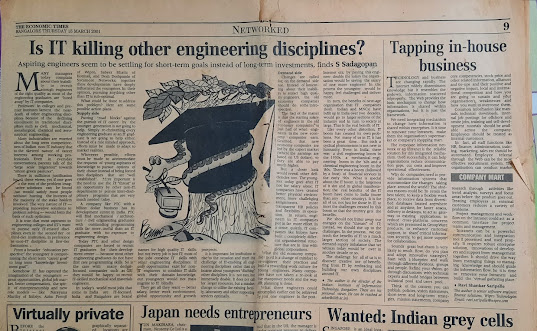Dear Friends and Students,
Yesterday, for the first time, India recorded a temperature
of 52.3 degrees Celsius. The government is examining the data. It may be an outlier or an issue
with the sensor! Perhaps the sensors installed were not designed for
temperatures beyond 50 degrees Celsius. While this is being debated, Nagpur
recorded a staggering 56°C (TOI, 31-05-2024). After a certain threshold
temperature, sensors might be behaving erroneously. Nevertheless, the point
here is that we have started talking about temperatures beyond 50°C!
Meanwhile, Himachal Pradesh is freezing! Kullu,
Shimla, and Kangra districts are experiencing extreme cold, with Lahaul-Spiti
being the coldest at a minimum temperature of 6.4°C. At the same time, Kerala
has been inundated due to incessant rains and is on red alert with the
monsoon's arrival!
I am not writing this post specifically about climate change, though a big call for action is
needed. However, the semiconductor industry needs to rethink and redesign for
the challenges posed by climate change.
Materials: The common materials used are silicon, gallium arsenide, germanium, and
silicon carbide, etc. Do we need alternative materials to withstand these
extreme contractions and expansions?
Purity: Extremely high purity is required for semiconductor materials.
Impurities can significantly affect the performance of semiconductor devices.
Are climate change actions causing any purity issues? This could be another
research problem.
Doping: Controlled introduction of impurities (dopants) is used to modify the
electrical properties of semiconductors. Can we solve current issues using
doping? This could be another research problem.
Otherwise, photolithography (a critical process in
semiconductor manufacturing that uses light to transfer a geometric pattern), etching,
and deposition (techniques to remove material and add layers of materials
to create the semiconductor device's structure) need alternative techniques!
This is the challenge for semiconductor industries like Intel, Samsung, NVIDIA
Corporation, Broadcom Inc., Qualcomm, Texas Instruments, Micron Technology,
Advanced Micro Devices, Inc. (AMD), Infineon Technologies AG, Taiwan
Semiconductor Manufacturing Company (TSMC), etc.
Climate change is going to change every aspect of life. It will decide what you eat, what
you wear, what you see, what you do, what you think, whom to marry, where to
travel, and so on.
On a lighter note, when a movie revolves around the condition
of having a toilet in the home, these hot, cool, or wet locations might decide whom and when
to marry! Yesterday, an air conditioner caught fire in some city due to long
usage! If an AC is not used for a long time, the human body burns in these
heat waves. Now you can understand how deep these research and tech problems
go!
Electronics and Communication Engineers, this is a call for
action! There is a lot of work for you now!
Ravi Saripalle

